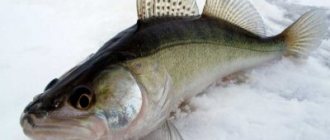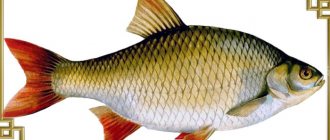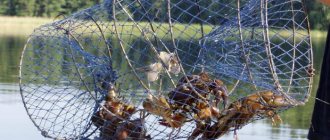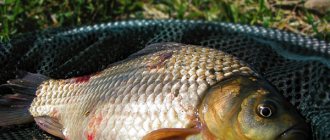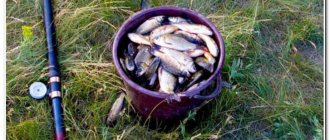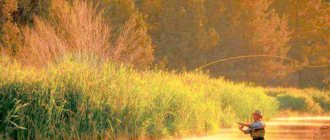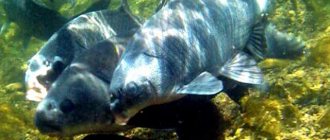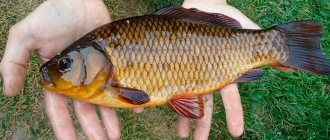Fishing for crucian carp in September
Peculiarities of crucian carp fishing in September
At the end of August and beginning of September, sudden natural changes occur in the life of reservoirs caused by a decrease in solar activity. The consequences of these changes are:
- reduction in temperature parameters of water and air;
- increasing water transparency;
- reduction in the active life of fish;
- preference by fish for more high-calorie food than in summer, since autumn is the period when fish accumulate reserves for the winter.
The weather and time of day have a great influence on the bite of crucian carp in September:
- the best for fishing is clear, sunny weather - in bad weather the bite stops;
- if the nights are still warm, the periods of active biting remain early morning and evening, as in summer;
- after the arrival of cool nights, the bite begins after the water warms up in the morning, from 11-12 o’clock or later. At the first signs of sunset and evening air cooling (16-17 hours) the biting stops.
Where and at what time is it better to fish?
In September, when the water in the reservoir is still warm, crucian carp continue to feed near the shore. This fish responds well to bait. If the temperature is high, then autumn fishing is no different from summer. When it gets cold, the fish becomes very passive, goes deep under the water into the so-called holes, from which no bait will lure it. During this period, fishing is not so easy, but it is possible. You need to find a hole in which the crucian carp are located. It is better to pour the bait near it. If there is no bite within 10 minutes, look for another place. The bite may resume if it gets warmer outside and the sun warms up the water. But in bad weather, crucian carp are practically inactive.
Where to catch crucian carp in September
The most favorable places for catching crucian carp in September, both with a float rod and with a feeder, depending on the temperature parameters of the environment, are conventionally divided into two periods:
- Daytime weather is characterized by almost summer temperatures. There is a lot of food in the coastal vegetation - larvae, beetles, small crustaceans. During this period, the best fishing for crucian carp is near the borders of coastal vegetation, especially if there is a breeze towards the shore. This period ends in the middle of the month.
- The water in shallow waters cools, coastal vegetation dies off - food in the coastal zone becomes scarce. Crucian carp moves to deep areas of the reservoir. The best places for fishing are exits from pits and places with warm water, for example, discharges of thermal power plants. This period begins in mid-September and can last until the end of October.
We advise you to read the report on fishing on the Don River (wintering pit, Volgograd region): catching large crucian carp on a feeder
Do you live near the Tsimlyansk Reservoir? The best places to go fishing!
Important! An exception to the general rule is deep flowing water bodies saturated with oxygen - in such water bodies the fish remain active throughout September. The most productive depth for fishing is from 3 to 5 meters.
Behavior of crucian carp in early autumn
The heat-loving crucian carp fattens up in this autumn month so that with the onset of cold weather it can go to a wintering pit or simply bury itself in a thick layer and there, being in a daze, calmly wait out the cold.
The bite of this fish, in comparison with the summer bite, becomes more confident. Fish react less to baits of plant origin.
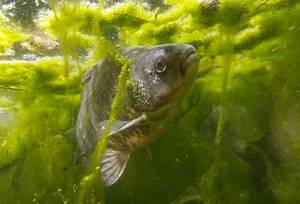
Even in autumn, cautious crucian carp prefers to stay near thickets of aquatic vegetation.
The lower the air and water temperatures become, the more actively the crucian carp introduces foods rich in animal protein into its diet.
In rivers during the day, crucian carp begin to emerge more often from grass shelters and appear in well-warmed sections of the river, even if the current there is quite strong.
On lakes, reservoirs, and canals, crucian carp often appear in shallow water (including sandy water). Reacts well to bait. As the water gets colder, crucian carp moves to deeper places. During this period, it is good to look for crucian carp at the entrances and exits of pits. The colder the weather, the deeper the crucian carp will stand.
It is difficult to say anything definite about the time for catching crucian carp with a float in this autumn month - crucian carp behave differently in each body of water. It is believed that in September it starts pecking later and ends shortly before sunset. But this is far from a fact.
What to use to catch crucian carp in September
The best results in autumn fishing are achieved by using animal baits:
- bloodworm;
- maggot;
- worm;
- amphipod (mormysh);
- sandwiches.
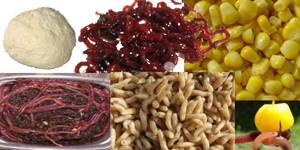
On warm autumn days, crucian carp may bite on vegetable baits - bread crumb, mastyrka, mash, canned corn, etc. Read also: Crucian carp killer - pea mastyrka
In some reservoirs, the volume of bait matters - the fish prefers a large bunch of bloodworms or maggots, several small worms instead of one large one. Sandwiches are also made up of, for example, 2-3 maggots and the same amount of bloodworms.
Read also: Styrofoam for crucian carp? YES!
Fishing for crucian carp in September using a float rod

It is more preferable to catch crucian carp in September with a float rod from the shore than by other methods. The key to success is durable but sensitive tackle:
- Telescopic rod from 4 to 7 meters. Short rod options (4-5 m) are for fishing from a boat, long rods (6-7 m) are for fishing from the shore.
- Floats with a carrying capacity of 1.5 - 3 g for heavy loading of gear. The need for such loading is determined by frequent windy weather in September. Floats with a small and medium-sized body, floats with a metal keel, as well as feather floats with fastening at the lower point are good.
- The hook must have a long shank and match the bait. For attaching baits such as bloodworms and maggots, it is best to use thin hooks No. 12-16, for a worm No. 8-12.
- For fishing with a float rod from a boat, it is convenient to use a jig.
- For catching large specimens, the ideal option would be a spinning reel with a brake adjusted to the strength of the leash. Reel size from 1500 to 2500.
- A sufficient thickness of the main line will be from 0.15 to 0.2 mm, provided that the fishing is carried out in water areas where there is no dense vegetation; • in conditions when fishing in dense coastal vegetation and frequent snags occur, the thickness of the main line reaches 0.35 - 0.4 mm; • the thickness of the leash is selected to be 0.05 – 0.1 mm less than the thickness of the main line; • the color of the main line and leash is matched to the color of the water in the pond or the color of aquatic vegetation.
- The tackle should be adjusted so that the bait touches the bottom and does not lie on it.
- From mid-September there comes a period when crucian carp are often hungry. Therefore, when equipping a fishing rod, it is necessary to take into account that the fish bite can be sharp and the resistance desperate, since in the fall large crucian carp bite more often than in the summer.
Read also: How to equip a float rod for catching crucian carp
Preparing gear
Due to the specific behavior of fish and the need to fish areas far from the shore, the best tackle for autumn fishing is donka. But if deep-sea points occur directly near the coastline, you can continue fishing with a float rod, because it is characterized by higher sensitivity, which is important in case of poor and sluggish biting. The fishing rod is rigged in the same way as at any other time of the year. The only differences may relate to the choice of float: if fishing is carried out in calm water, it makes sense to give preference to floats with an elongated shape, while its carrying capacity should correspond to the depth of the location. Too thin products with low carrying capacity will not be able to detect a bite at a depth of 2-3 meters.
When choosing a bottom fishing method, you need to prepare a short telescopic rod. Based on the fact that you won’t have to make very long casts, this type of tackle will fully justify itself.
The optimal weight of a feeder with bait and hooks is 10-20 grams. When examining quiet places with little current, it makes sense to use spring feeders or advanced “methods”.
Read: Fishing for perch in early summer
The latter type of feeders is characterized by the ability to contain large volumes of bait mixture, as well as deliver it to a specified place. To make your fishing more targeted, you can consider open, flat-bottomed fishing feeders called “flats.” Due to their specific design, they lie completely on the bottom, attracting large prey.
When fishing in the fall, it is quite reasonable to use two hooks on one tackle. This approach will allow you to determine the most optimal bait in a short time, and will also increase your chances of catching a large trophy. But if the location is full of various snags and bottom obstacles, it is better to stick to one hook.
Fishing for crucian carp in September on a feeder
The feeder has clear advantages over the float rod, especially from the second half of September, when the crucian carp moves away from the banks into deep holes. In addition, the feeder is little susceptible to wind, and windy weather in the fall is far from uncommon.
Advice! For catching crucian carp on a feeder in September, the best reservoirs are those with a bottom that is attractive for fish to live in - holes, a clearly defined channel, various irregularities and a slow flow.
The following requirements apply to feeder gear for catching crucian carp:
- a medium or medium-fast action rod with a weight of up to 60 grams and a length of 3-3.6 meters;
- spinning reel sizes from 1500 to 2500;
- main monofilament line 0.18-0.22 mm, for leashes 0.12 - 0.16 mm;
- It is advisable to use thin hooks No. 12-15 for maggots and bloodworms, No. 8-12 for a worm;
- All known feeder equipment is used - paternoster, symmetrical and asymmetrical loop, etc.
In general, it should be noted that although many fishermen consider crucian carp fishing in the first autumn month to be unpromising, in fact, success depends on the choice of fishing location and quality preparation.
Fishing spot
Crucian carp in September
The most important thing for a good crucian bite is the location. Without a well-chosen place there will be no bite. For catching crucian carp in September, an artificial pond with a dam or a small lake with a heterogeneous bottom 4-5 m deep is ideal. This composition of the bottom creates the most favorable conditions for the life of September crucian carp. But in deeper and flowing reservoirs, saturated with oxygen, the activity of crucian carp does not stop until the end of autumn.
Where should you look for crucian carp in September?
When going fishing, you need to take into account the behavior of fish in September. Due to the decrease in water temperature, crucian carp move to deeper areas. These can be holes at the bottom or places where water is discharged near the dam, which are characterized by different bottom topography and slow flow. On such dams, both gold and silver crucian carp are excellently caught. In such places, it is customary to catch this fish using a half-bottom, feeder, or picker.
Bait recipe for crucian carp in September
Bait remains a prerequisite for successful fishing.
The principle of complementary feeding is changing - a minimum amount with an increased calorie content. September bait has its own characteristics:
- flavors in cold water spread more slowly and over a shorter distance;
- in clear water, the value of the color of the groundbait, “cloudy” additives – oatmeal, bran, dry milk, flour and living moving components – increases – the content of bloodworms, worms, maggots in the bait should reach 2 – 5%));
- increased caloric content and a minimal amount of bait should attract fish and force them to actively feed without causing satiety.
Bait for catching crucian carp in September using a float rod
Store-bought baits are good options, but they require the addition of animal ingredients, and soil cannot be added to them in the fall. Basic requirements for the use of bait in September:
- most of the bait - from 4 to 6 balls the size of a tennis ball, is thrown at the beginning of fishing, and often the need for additional feeding not only does not arise, but can also ruin the bite;
- The next portion of bait should be added only when the biting stops completely. A sufficient amount is 1 ball of bait every 45-60 minutes.
Bait for catching crucian carp in September on the feeder
In addition to commercially available baits, fishermen use homemade ones. For example, mix one part each of bran, breadcrumbs, ground rolled oats, crushed hemp and peanuts, ground grain, two parts of corn flour and an animal component. Cocoa is used as a dye.
For September feeder fishing for crucian carp, anglers use the following tactics - all the bait is thrown into the fishing spot at the beginning of fishing, and fishing is done with a load on the rig instead of a feeder. In this case, the risk that the fish will be overfed is reduced.
Tackle for catching crucian carp in autumn

You can catch crucian carp in the fall using both a regular float rod and bottom tackle (feeder). Moreover, with the arrival of autumn, it should be thinner, since the water becomes more transparent, which is very important. Crucian carp may notice a thick fishing line and refuse to bite, moving away from the dangerous place.
In order for the crucian carp to still risk trying the bait offered to it, it is advisable to use a very thin fishing line: the thinner, the better. If the fishing gear is a regular fishing rod, then the most suitable line will be a fishing line with a thickness of 0.1 to 0.15 mm. When fishing with bottom tackle (on a feeder), you can increase the thickness to 0.18 mm. As a rule, mostly small specimens are caught on the hook and such a thin fishing line is enough. But if large crucian carp is caught in a reservoir, then the thickness of the fishing line should be selected taking into account this factor.
The tackle should not only be invisible to crucian carp, but also quite sensitive. The sensitivity of the tackle is determined by the weight and shape of the float. In autumn, it is advisable to use floats such as a quill pen or pencil. They are considered the most sensitive. This is due to the fact that crucian carp takes the bait quite carefully in the fall and not every float is able to record these careful bites. In addition, other types of floats, due to the peculiarities of their shape, can simply scare away the fish.
As for the selection of the hook, its size should correspond to the size of the fish, as well as the nature of the bait used. If you use very thin tackle, with a fishing line of 0.1-0.15 mm, then a hook No. 15-10 on the international scale is sufficient. If larger crucian carp are caught (from 500 g or more), then the hook size can be increased. In any case, the hook should fit freely in the fish's mouth.

